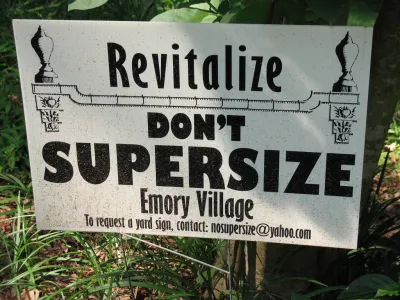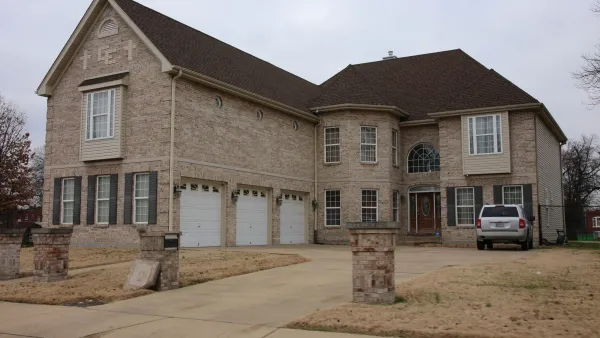Henry Grabar beckons the death of the McMansion, calling it an "American embarrassment" with no easy solution for planners.

Grabar describes the implications of the growing size of American homes, which has consistently expanded on average since the Truman Administration: "This surfeit of space is a potent symbol of the American way of life; it speaks to our priorities, our prosperity and our tendency to take more than we need. But the superlative size of our houses isn’t just a foam finger America can hold up to the world. It’s correlated with land use patterns and population density, which in turn determine the environmental impact and personal health of communities, and whether they can support a diverse range of businesses, facilities and transportation choices."
There was a temporary blip in the trend of expanding house size, however, during the most recent recession: "Between 2007 and 2010, for the first time in a half century, the average size of new U.S. homes fell by more than a hundred square feet, dropping back toward 2004 levels."
Grabar credits some critics who saw that report as good news, but the trend of constraint has not held through the economic recovery: "last year, the average size of new American houses reached an all-time high of 2,679 square feet. The increase in space per person has been even more dramatic. Between 1973 and 2013, the average American household shrank from 3.01 to 2.54 persons; new homes give Americans more than 1,000 square feet per family member, on average. That’s roughly twice as much space as we had in 1973."
Grabar goes on to describe some of the challenges that the American appetite for large homes presents for planners, especially considering that economic growth is a greater driver of urban expansion than population growth.
FULL STORY: We must kill the McMansion! Good riddance to an American embarrassment

National Parks Layoffs Will Cause Communities to Lose Billions
Thousands of essential park workers were laid off this week, just before the busy spring break season.

Retro-silient?: America’s First “Eco-burb,” The Woodlands Turns 50
A master-planned community north of Houston offers lessons on green infrastructure and resilient design, but falls short of its founder’s lofty affordability and walkability goals.

Delivering for America Plan Will Downgrade Mail Service in at Least 49.5 Percent of Zip Codes
Republican and Democrat lawmakers criticize the plan for its disproportionate negative impact on rural communities.

Test News Post 1
This is a summary

Test News Headline 46
Test for the image on the front page.

Balancing Bombs and Butterflies: How the National Guard Protects a Rare Species
The National Guard at Fort Indiantown Gap uses GIS technology and land management strategies to balance military training with conservation efforts, ensuring the survival of the rare eastern regal fritillary butterfly.
Urban Design for Planners 1: Software Tools
This six-course series explores essential urban design concepts using open source software and equips planners with the tools they need to participate fully in the urban design process.
Planning for Universal Design
Learn the tools for implementing Universal Design in planning regulations.
EMC Planning Group, Inc.
Planetizen
Planetizen
Mpact (formerly Rail~Volution)
Great Falls Development Authority, Inc.
HUDs Office of Policy Development and Research
NYU Wagner Graduate School of Public Service





























